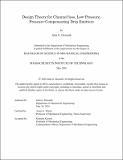Design Theory for Channel-less, Low-Pressure, Pressure-Compensating Drip Emitters
Author(s)
Howarth, Julia G.
DownloadThesis PDF (1.024Mb)
Advisor
Winter, Amos G.
Terms of use
Metadata
Show full item recordAbstract
Drip irrigation is a tool used to aid farmers in water scarce locations by offering a higher water efficiency than conventional methods. However, drip systems require larger energy input thus increasing capital and operating expenses posing a barrier to its adoption, specifically in lower-middle income countries (LMIC). Low-pressure drip irrigation (LPDI) has been proposed as a way to achieve water-efficient drip systems with reduced operating expenses. Another barrier to adoption is clogging within emitters that leads to increased maintenance costs and lifespan constraint of the system. To address this challenge, this thesis proposes a design theory for emitters that could be clog-resistant in addition to being low-pressure by removing the smallest hydraulic feature of conventional emitters, the channel. The designs proposed are ‘channel-less’ and replace the pressure-varying hydraulic resistance of the channel with hydraulic resistance stemming from offsetting the outlet of the emitter away from the center axis of the emitter pocket, which is where it is conventionally located. The design theory hypothesizes that as the flexible diaphragm deflects and begins to cover the offset outlet, the gap that flow is able to exit through decreases producing a hydraulic resistance that allows for a constant flow rate. To define this moment of activation, an analytical structural model is used to correlate diaphragm deflection with experimentally observed pressure-compensating (PC) regions for a series of emitters with varying lands depths and outlet positions. Experiments of nine channel-less emitters resulted in six emitters with PC capabilities and activation pressures as low as 0.4 bar and flow rates ranging from 1.3 - 1.8 L/hr. The knowledge of when activation occurs in a channel-less emitter will allow designers the ability to vary geometric parameters and create a low-pressure, channel-less (LPCL) emitter that reduces operating expenses and clogging related barriers against drip adoption.
Date issued
2024-05Department
Massachusetts Institute of Technology. Department of Mechanical EngineeringPublisher
Massachusetts Institute of Technology